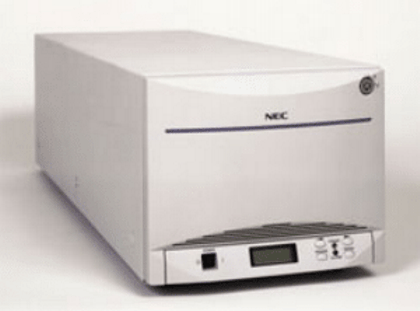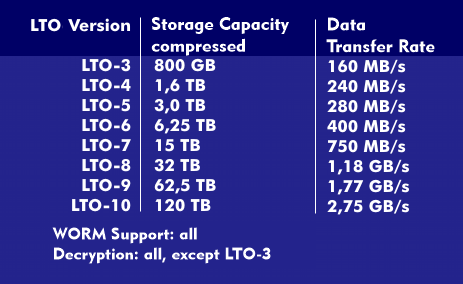linear tape open (LTO)
Linear Tape Open (LTO) is an open format for digital tape drives developed by IBM, HP and Seagate in 1998 for midrange data technology. As the name suggests, LTO drives use longitudinal tracking, where the individual tracks in which data is recorded run the entire length of the magnetic tape.
LTO drives used in data backup and archiving work with 1/2" cartridges and have storage capacities ranging from 100 GB to 6,400 GB (uncompressed) and data transfer rates from 20 MB/s to 750 MB/s for uncompressed data. Expanded into tape libraries, they can be up to several thousand terabytes( TB) in size
LTO cartridges are 105 x 102 x 21 mm in size and have a cartridge memory( CM) on which the table of contents is stored. The LTO tape drives work with error detection and compression methods and have connections forSCSI or Fibre Channel( FC), depending on the version
The different LTO drives
Compared to conventional tape drives, LTO has the advantage that cartridges from different manufacturers are write and read compatible with LTO drives from other manufacturers. The LTO standard recognizes two tape formats that are compatible with each other: Ultrium, which is optimized for high storage capacities and for data backup, and Accelis, which features short access times and is designed for archiving. Ultrium/LTO comes in several formats with 100 GB (LTO-1), 200 GB (LTO-2), 400 GB (LTO-3), 800 GB (LTO-4), 1,600 GB (LTO-5), 3,200 GB (LTO-6) and 6,400 GB (LTO-7), whose values refer to the uncompressed storage capacity. For compressed data, the storage capacity is more than double. The Accelis format has 50 GB, a data transfer rate of 40 MB/s and an access time of about 10 s.
LTO-7 and the roadmap for further LTO drives
The LTO roadmap shows the development of LTO drives from LTO-7 to LTO-10. LTO-7 has been available since the beginning of 2016 and replaces LTO-6. It has a storage capacity of 6.4 terabytes of uncompressed data and 15 terabytes of compressed data. The data rate is 750 MB/s. The compression ratio is 2.5:1. LTO-7 supports partitioning of the data.
The other LTO variants are LTO-8, LTO-9 and LTO-10. LTO-8 has double the storage capacity of LTO-7 with 12.8 TB (uncompressed) and 32 TB (compressed), the data rates are 472 MB/s (uncompressed) and 1.180 TB/s (compressed). LTO-9 has a storage capacity of 26 terabytes (TB) (uncompressed) and 62.5 terabytes (TB) (compressed) and data rates of 708 MB/s (uncompressed) and 1.770 TB/s (compressed), and LTO-10 has a storage capacity of 48 terabytes (TB) (uncompressed) and 120 terabytes (TB) (compressed) equipped and data rates of 1.1 TB/s (uncompressed) and 2.75 TB/s (compressed).
WORM and encryption technology
All LTO versions support data protection through WORM technology and encryption, except LTO-3. WORM technology, Write Once Read Many (WORM), ensures that once data is stored, it cannot be overwritten or erased. The technique works with special WORM storage cartridges. As far as encryption is concerned, LTO technology uses 256-bitAES encryption, which protects data during archiving and transport.
Furthermore, since the LTO-5 version, LTFS technology, Linear Tape File System (LTFS), is used, a file system for archiving. The magnetic tapes behave like hard disks. The data for data storage is defined in a hierarchical directory structure and can be retrieved under all operating systems. The metadata is stored on the magnetic tape.



